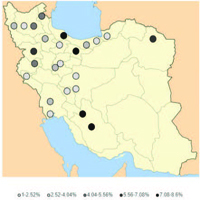 Smart Citations
Smart CitationsSee how this article has been cited at scite.ai
scite shows how a scientific paper has been cited by providing the context of the citation, a classification describing whether it supports, mentions, or contrasts the cited claim, and a label indicating in which section the citation was made.
Infection status of hydatid cysts in Iran: A review
Cystic echinococcosis (CE) is a significant zoonosis, and is endemic in some parts of the world including Iran. Hydatid cyst in Iran has been studied from different aspects and has been reported from most parts of the country. But there is no comprehensive report on the appearance of pollution in the country. This study was conducted to investigate the approximate status of infection from 1985 to 2019. In this review article, various reports on hydatid cysts were collected from 1985 to 2019. According to three criteria, i.e. the rate of infection of dogs with adult worms, the rate of infection of livestock, and the rate of infection of humans with hydatid cysts, the articles were summarized and presented to approximate the status of infection in Iran. In this study, the average infection among 11593 dogs was estimated to be 11.28%. In the case of livestock, according to this review, the maximum infection of sheep was in Ardebil with 74.4%, goats and cattle were in Sari with 37.8% and 40.1%, camels in Khorasan Razavi with 40.40%, and Tabriz had the highest amount of infection in buffaloes. Out of 70907 people tested, the summary of seroepidemiological studies shows that the average infection in humans is 5.57%. The information obtained from this review article shows that despite the efforts of health organizations and veterinary organizations, the rate of infection in Iran is still high compared to some countries.
How to Cite
PAGEPress has chosen to apply the Creative Commons Attribution NonCommercial 4.0 International License (CC BY-NC 4.0) to all manuscripts to be published.







